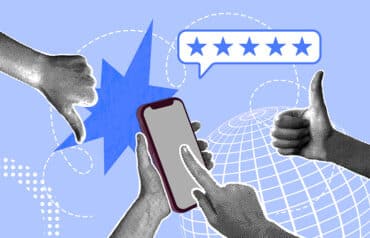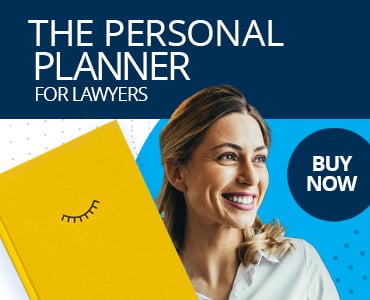Many lawyers are uncomfortable working in their firm’s trade show booth. Make your time on the expo floor less stressful with this checklist.

Table of contents
Not so long ago, suggesting that lawyers would stand behind a table at a trade show would have been deemed heretical. Times have changed. Recently, I’ve heard a number of people discuss their firms’ participation in the Association of Corporate Counsel conference, specifically having a booth in the exhibit hall. I know law firms that send lawyers to staff booths at association meetings representing everyone from HR managers to shopping centers to insurance carriers.
While exhibiting at conferences may have become a mainstream activity, many lawyers are uncomfortable with their roles in these forums. But there is a lot you can do to make your participation more effective and less stressful.
Preparing for the Trade Show
As with all marketing activities, execution becomes easier with preparation. Here are some things you should do before showing up at the booth:
- Prepare your elevator speech. Be ready to explain, in a brief and understandable way, the kinds of clients you represent and how you help them. Tailor this to the attendees or industry that the conference represents.
- Research the association. What is its mission? What member benefits does it offer? You should know how your firm fits in.
- Research the attendees. Who are they? What are their job titles? Do you have any clients or other contacts who will be in attendance? Create a target list of people you’d like to see and, if possible, contact them directly to set up times to meet.
- Note the sponsors, board members and conference planners. It’s always good to know who is responsible for making the program successful.
- Note your competitors. Are other law firms exhibiting or presenting? If so, who are they and how will you differentiate yourself from them?
- Develop a pre-conference activity. If you are a sponsor or exhibitor, many organizations will give you an opportunity to reach out to the attendees beforehand. Think about something you can do to engage them or make them interested in seeking out your booth, like offering the results of a survey or a useful giveaway. At a minimum, create some takeaway or cool swag so you have something of perceived value in the booth.
- Read the conference materials. Familiarize yourself with the program sessions and activities. Who is the keynote speaker, for example? Plan your days so you maximize your time at the exhibit hall, during the conference and after hours (e.g., social events).
- Announce your activity. Use social media or direct contact to let people know you’ll be there.
Additional Activities
- Define clear objectives and KPIs: Don’t just attend; know why you’re there. Define specific, measurable goals (e.g., number of qualified leads, brand mentions on social media, meetings scheduled).
- Develop a social media strategy: Create a pre-show buzz by announcing your attendance, sharing behind-the-scenes glimpses of booth setup, and using relevant event hashtags. Plan content to be shared during and after the event as well.
- Pre-schedule meetings: Use LinkedIn and other platforms to connect with key attendees beforehand and schedule meetings at your booth. This maximizes your time and ensures you connect with the right people.
- Design an engaging booth experience: Move beyond static displays. Consider interactive elements like touchscreens showcasing case studies, virtual reality demos of your services, or a charging station with branded giveaways.
- Prepare digital collateral: Instead of relying solely on printed materials, have digital brochures, case studies, and presentations readily available on tablets or via QR codes that attendees can scan with their smartphones.
- Equip staff with mobile lead capture tools: Use apps or CRM integrations to quickly and efficiently capture leads digitally, eliminating the need for business card collection and manual entry.
- Train staff on social media engagement: Ensure your team knows how to use the event hashtag, post updates from the booth, and interact with attendees online.
- Coordinate with marketing team for pre-show promotion: Ensure your attendance is promoted on your firm’s website, blog, and social media channels. Send targeted emails to clients and prospects in the region.
During the Event
Once you’re in the exhibit hall, keep the following in mind:
- Engage people as they walk by. Make eye contact, smile and say hello. Everyone likes seeing a friendly face.
- Shake hands. When people stop in your booth, introduce yourself with a firm handshake. Wear your nametag on your right side. Be ready with your elevator speech when people ask about you or your firm.
- Ask open-ended questions. Try to qualify whether the visitors are good targets. For example: What is your role at XYZ Company? What are the company’s biggest issues related to [your practice area]? What are you looking for in the exhibit hall?
- Use open and engaging body language. Smile, nod your head and maintain eye contact. Don’t look around, cross your arms, put your hands in your pockets or turn sideways.
- Make interacting with visitors your only activity. Don’t eat, drink, sit down, talk to your colleagues or use your phone while in the booth.
- Be enthusiastic when talking with people. Demonstrate that you want to learn more about the industry or profession of the attendees. Show passion about what you do.
- Announce your presentations. If you or one of your colleagues is speaking at the conference, have a sign at the booth indicating the date, time and topic.
- Keep conference information handy. Just being able to answer questions about what sessions are coming up, when and where, will make you helpful.
- Use visitors’ names. And thank people for stopping by.
- Thank the organizers. Look for board members, conference planners and the association management to thank them for the opportunity and congratulate them on the meeting.
Additional Activities
- Actively engage on social media: Live-tweet from the event, post photos and videos of your booth and team, and respond to mentions and comments. Run contests or giveaways to boost engagement.
- Use digital lead capture tools: Scan badges or use dedicated apps to collect leads seamlessly. This data can be instantly synced with your CRM for immediate follow-up.
- Offer interactive experiences: Engage attendees with demos, quizzes, or interactive presentations. This creates memorable experiences and facilitates deeper conversations.
- Monitor social media for mentions and opportunities: Track the event hashtag and your firm’s name to identify potential leads, influencers, and networking opportunities.
- Collect data and feedback: Use surveys or feedback forms (digital or print) to gather information about attendees’ needs and how your firm can help.
- Network strategically: Don’t just stay in your booth. Encourage staff to attend relevant sessions, network with other exhibitors, and actively participate in event activities.
Follow-up Checklist
As is true with nearly every marketing activity, the return on your investment will go up with diligent follow-up. Here are some suggestions:
- When a visitor leaves the booth, immediately make notes. You can use the backs of business cards or the attendee list to record details about the person, what you talked about and the follow-up you should undertake.
- Add visitors to appropriate lists. This could be your own prospect list or firm databases for things like webinars and alerts.
- Send a personal note with some value-added information. Examples include a substantive article, a contact name or a copy of a case. It might also be something of a more personal nature, like a review of a restaurant you discussed.
- Connect on LinkedIn. Send a personal invitation reminding the person that you met at the trade show. Look for contacts you have in common.
- Set up alerts. If you met some good prospects, set up Google or other alerts to notify you of developments. These can identify opportunities for you to get back in touch.
- Target people who didn’t attend. You can use your presence at the conference as a value-add for people who couldn’t make it by sending out a summary of some of your favorite sessions or sharing materials.
- Conduct a post-mortem. Whether you do this individually or as a firm, you should take some time while the trade show is still fresh in your mind to review your activities and performance. What could you have done better? What should you note for the next time around?
Additional Activities
- Immediately upload leads to CRM: Ensure all captured leads are promptly uploaded to your CRM system for efficient tracking and follow-up.
- Personalize follow-up communications: Tailor your follow-up emails or calls based on the specific conversations you had with each lead. Reference shared interests or needs discussed at the booth.
- Share valuable content: Send relevant articles, case studies, or blog posts that address the specific challenges or interests of each lead.
- Analyze data and measure ROI: Track key metrics like lead conversion rates, website traffic, and social media engagement to assess the success of your trade show participation.
- Follow up on social media interactions: Connect with new contacts on LinkedIn, engage with their posts, and continue the conversation online.
- Debrief with the team: Discuss what worked well, what could be improved, and gather feedback for future events.
Still Uncomfortable? Keep Attendees’ Goals in Mind
Remember, people who visit an exhibit hall are there to see products and services that will make their job easier or their business more successful; you should never feel uncomfortable talking about how you and your firm relate to the attendees’ market or industry. The key is to do it in a way that helps them understand what you, and your firm, can do to help.
Illustration ©iStockPhoto.com
Get “One Really Good Idea Every Day”
Sign up for Attorney at Work and help us grow! Subscribe to the Daily Dispatch and the Weekly Wrap (same price: free). Follow us on LinkedIn, Facebook and Twitter @attnyatwork.
















